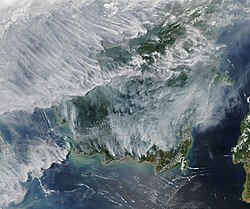
Back ضباب عام 2010 على جنوب شرق آسيا Arabic Kabut Asia Tenggara 2010 ID Ọkụ Ndịda Ọwụwa Anyanwụ Eshia nke afọ 2010 IG Jerebu Asia Tenggara 2010 Malay
| Southeast Asian haze series |
|---|
 |
| History |
| Key topics |
| Responses |
| See also |
|
|
The 2010 Southeast Asian haze was an air pollution crisis which affected many Southeast Asian countries such as Indonesia, Malaysia and Singapore during the month of October 2010.[1]
This occurred during the dry season in October when forest fires were being illegally set off by Indonesian smallholders residing in the districts of Dumai and Bengkalis, in the Riau province of Sumatra.[2] These farmers adopted the slash-and-burn method to clear off land rapidly for future farming opportunities.[3]
On 18 October, the hotspot count in Sumatra reached a maximum of 358.[1]
Due to the El Niño weather pattern, the westerly winds carried haze towards Indonesia's neighbouring countries causing the air quality in Malaysia and Singapore to dip to an unhealthy range for several days.[1] The hazy conditions not only resulted in the reduction in air quality but also caused poor visibility, multiple closures of schools in Malaysia and an influx of respiratory illnesses.[4]
During that time of the year, the recorded air quality in Singapore then was the worst it had ever been since 2006.[5]
Despite ministers meeting up a week before the crisis for the 6th meeting of the Association of Southeast Asian Nation (ASEAN) agreement, whereby issues on the transboundary haze and methods to tackle forest fires were discussed, the Indonesian government failed to successfully regulate and enforce laws on illegal logging.[6] This caused Indonesia to face much criticism from neighbouring countries.
On 24 October 2010, rainy conditions returned to Indonesia which helped to reduce the production of haze and provided relief to air quality levels.[1]
- ^ a b c d National Environment Agency (2010). "Annual Weather Review 2010" (PDF). Review of Weather Conditions in 2010. 1: 2–5.
- ^ "Worst haze from Indonesia in 4 years hits neighbors hard". Reuters. 21 October 2010. Retrieved 2019-05-12.
- ^ "Harvard-Columbia study finds that 2015 haze in Indonesia likely caused 100,300 premature deaths". Mighty Earth. 18 September 2016. Retrieved 2019-05-12.
- ^ "Haze from Indonesia hits neighbours | IOL News". www.iol.co.za. Retrieved 2019-05-12.
- ^ Cite error: The named reference
:7was invoked but never defined (see the help page). - ^ "Media Release of the 6th Meeting of the Conference of the Parties to the ASEAN Agreement on Transboundary Haze Pollution and the 12th Informal ASEAN Ministerial Meeting on the Environment Bandar Seri Begawan, 13 October 2010". ASEAN. 14 October 2010. Retrieved 2019-05-12.

